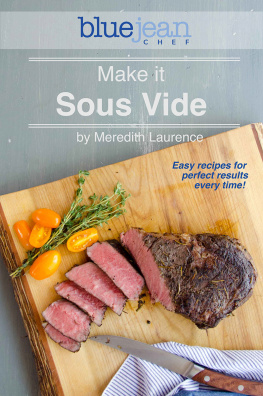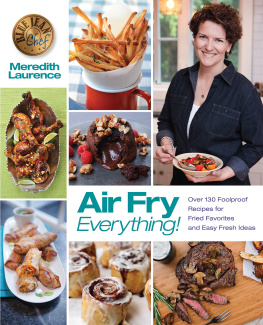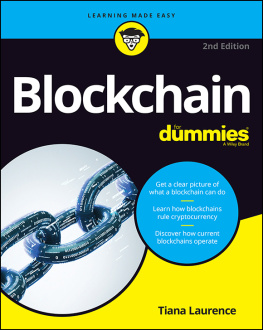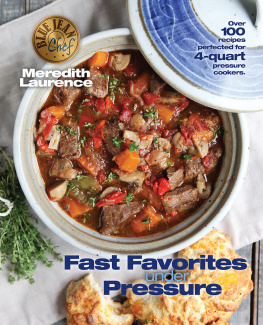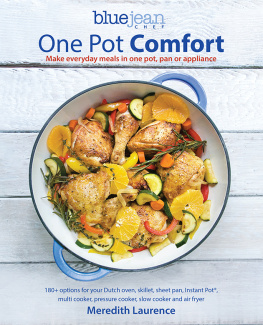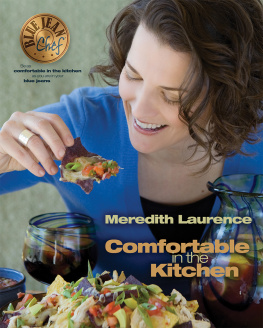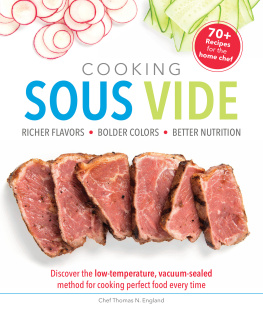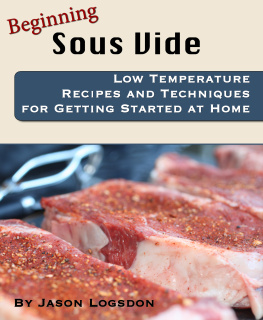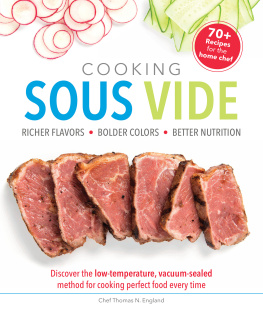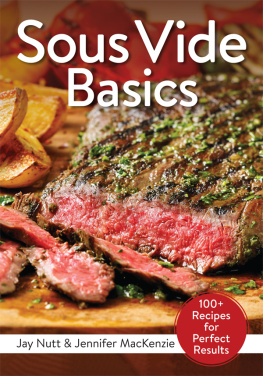Copyright 2018 by Meredith Laurence.
All rights reserved. No part of this book may be reproduced or transmitted in any form or by any means, electronic or mechanical, including photocopying, recording, or by any information storage and retrieval system, without written permission from the publisher.
Sous vide literally means under vacuum in French. When you cook something sous vide, food is placed in a vacuum-sealed bag in a water bath at precise temperatures, often well below the boiling point. Restaurant chefs have used this cooking method for years because it offers exact control of the finished product and leaves very little room for human error. For example, if you cook a steak in a water bath set at 140F, there is no way the steak can get hotter than 140F and so you end up with a perfectly cooked medium steak, whether you cook that steak for one hour or four hours.
In addition to delivering perfect results with very little effort, there are other advantages to sous vide cooking. The texture of food is enhanced when cooked gently in a water bath, rather than quickly on a stovetop. Cooking a pork shoulder for 24 hours in a sous vide water bath will give you pork that will just fall apart when shredded, but it wont be dry or over-cooked. Similarly, a brisket cooked sous vide can be super tender, but still have a little pink left to the meat. It will be tender without being cooked well done.
In addition, sous vide foods cook in a bag alone, in their own juices or with other ingredients that you put in the bag. There is no loss of moisture or flavor and in fact, foods can be infused with the flavors of other ingredients. Cooking halibut in a bag with butter and orange juice results in tender, moist and delicious fish infused with orange flavor.
Sous vide machines keep the water at a very precise low temperature. These machines used to be quite large and were therefore primarily used by restaurants rather than home cooks. These days, however, there are many brands of sous vide circulators that can be purchased at very reasonable prices, making sous vide practical for home use.
If you are thinking that sous vide cooking is complicated and really only suited to professional chefs, I implore you to think again. Sous vide cooking at home is relatively new, but it falls into the same category as slow cookers, pressure cookers and air fryers its another great appliance that can help home cooks get a successful dinner on the table with very little effort.
In order to cook sous vide, you will first and foremost need a sous vide circulator. This is the tool that will heat and circulate the water. Its usually not much bigger than an immersion blender and can be used in any vessel.
A large vessel is the next piece of equipment that you will need. I like to use a stockpot or container that is at least 8 quarts in capacity so there is plenty of room for both the circulator and the food Im cooking. Whatever you use just needs to be food safe and able to hold water. How big a vessel you can use is limited by the brand of circulator you buy. Check to see what maximum amount of water your circulator can efficiently heat and then youll know what size vessel to get. You can find a number of large restaurant style storage containers available for single purchase online.
Youll also need some zipper lock bags. I recommend freezer bags with a double zip seal. It is very important that no water enter the bag, so good-quality food safe bags are a must.
A vacuum sealer is certainly nice to have to remove the air from the bags, but its not critical. You can remove air from the bags in a number of ways, as you will see below.
The main reason you need to vacuum seal foods in a bag when cooking sous vide is so that the bag will sink in the water and not float. Its very important that the food be completely surrounded with the water, that it is fully submerged and not partially submerged, so that it cooks evenly. Certainly, the easiest way to do this with most foods is with a vacuum sealer (electric or hand pumped), but there are other ways to do this as well.
Water Displacement Method
If you have liquid in the bag along with the food you are cooking (a marinade, for example), it is difficult to vacuum seal the bag without sucking out all the liquid as well. In these instances, seal the bag almost completely and then lower the bag into some water. The water will displace the air in the bag. When you have lowered the bag almost completely, being sure not to let any water into the bag, finish sealing the zipper lock and the food should sink easily.
Countertop Method
Another way to remove air from a bag that has liquid inside is to use your countertop. Hold the bag by the zipper lock and let the food in the bag hang over the edge of the counter. Pull the bag up so that the top of the food almost starts to come over the edge of the counter. Smooth out the bag on the surface of the countertop to remove the excess air and then seal the lock on the bag.
How ever you seal the bags, remember that a good seal is critical to your success. If any water enters the bag, the food will be ruined and youll have to start again.
Knowing how long to cook foods and at what temperature is a puzzle to anyone new to sous vide cooking. I recommend starting with recipes until you get the hang of the technique. Then, at the back of this book, youll find extensive cooking charts with both time and temperature listed for different foods, from meats to vegetables to desserts and dairy products.
Seasoning your foods with salt is very important, but you have the option of seasoning before you cook sous vide or afterwards, once the food comes out of the bag. Salt does affect foods in more ways than just bringing out flavors. It draws out moisture and therefore changes the textures of foods, making it firmer. Sometimes you want that texture change (as with fish) and sometimes you dont (as in flank steak).
I generally use time as the determining factor for when I season foods. If the food is cooking sous vide for a shorter period of time (under 2 hours), Ill season before I put the food in the bag. If it is cooking for a longer period of time, Ill season after the food comes out of the bag.
While cooking sous vide will give you perfectly and evenly cooked foods that are tender and moist, it wont brown at all and cant create a crust on the exterior of foods. So, to remedy that shortcoming, its common to sear foods either before or at the end of sous vide cooking.
Searing food before you put it in the bag will give you some color, but the texture that searing provides will be lost after the food has cooked in its own juices for a little while. The advantage to searing ahead of time is that it can help adhere a seasoning to the food, and it gives you a head start so that if you choose to sear the food at the end of cooking, you already have some color to start with.

